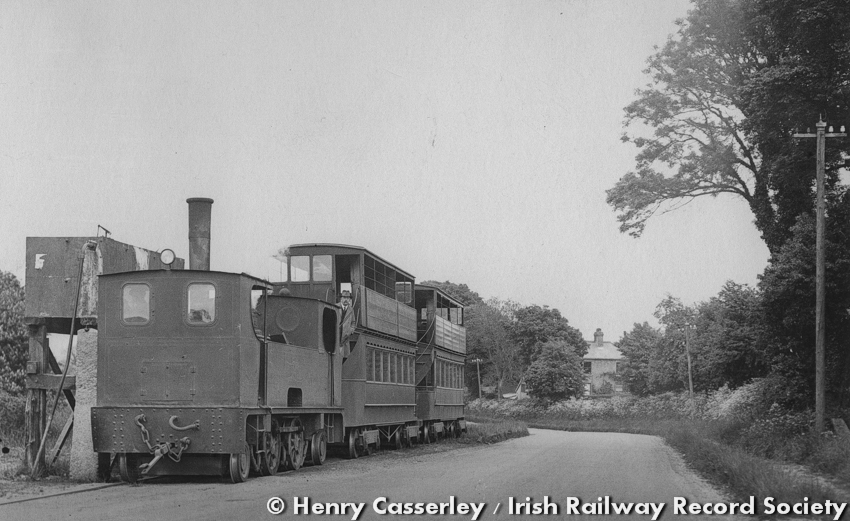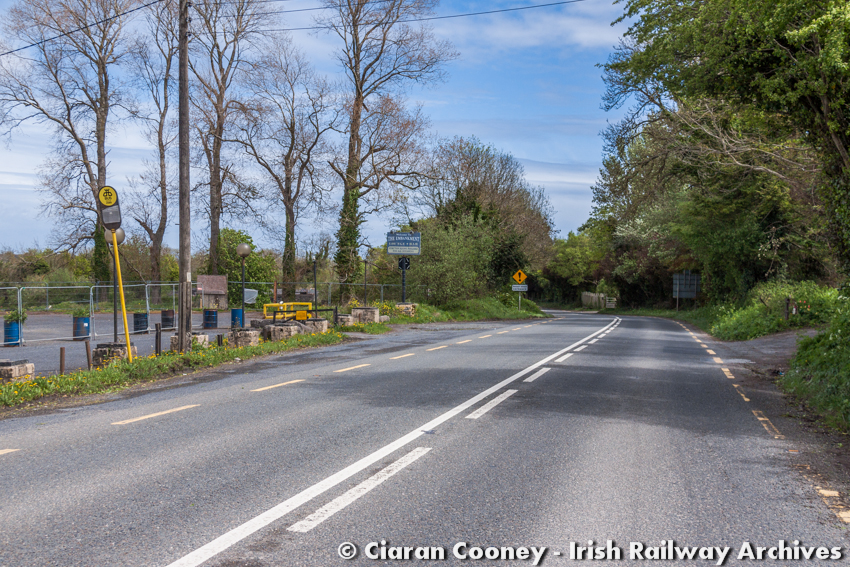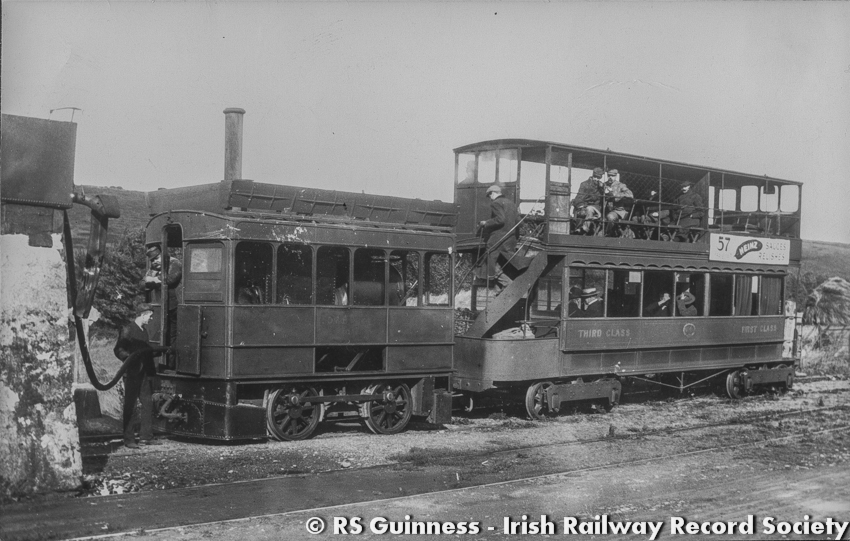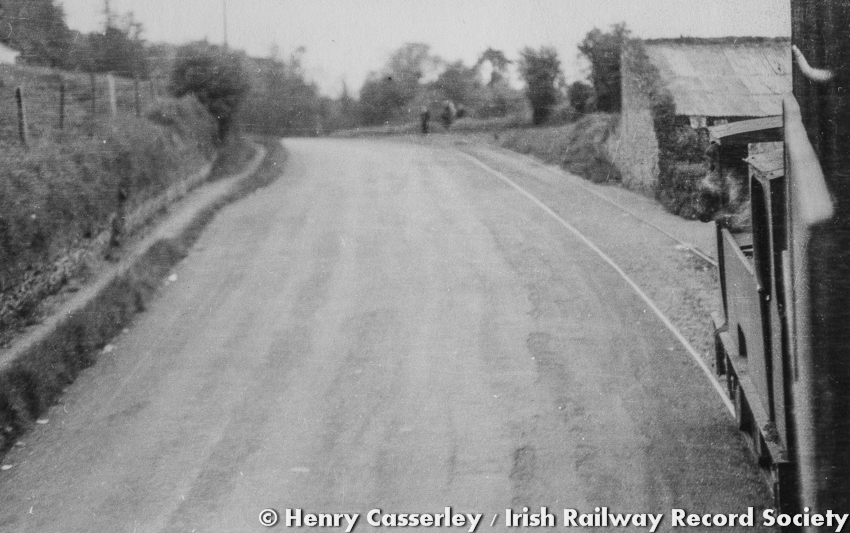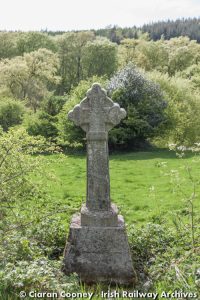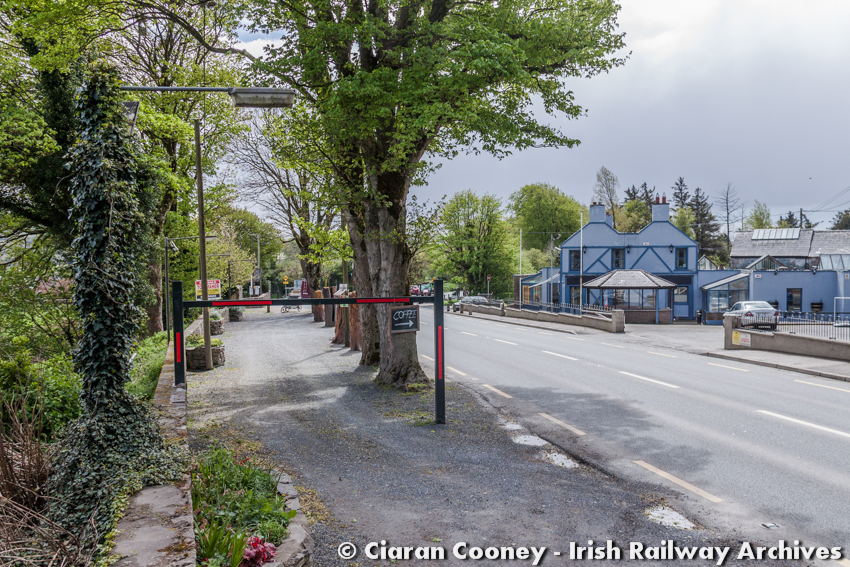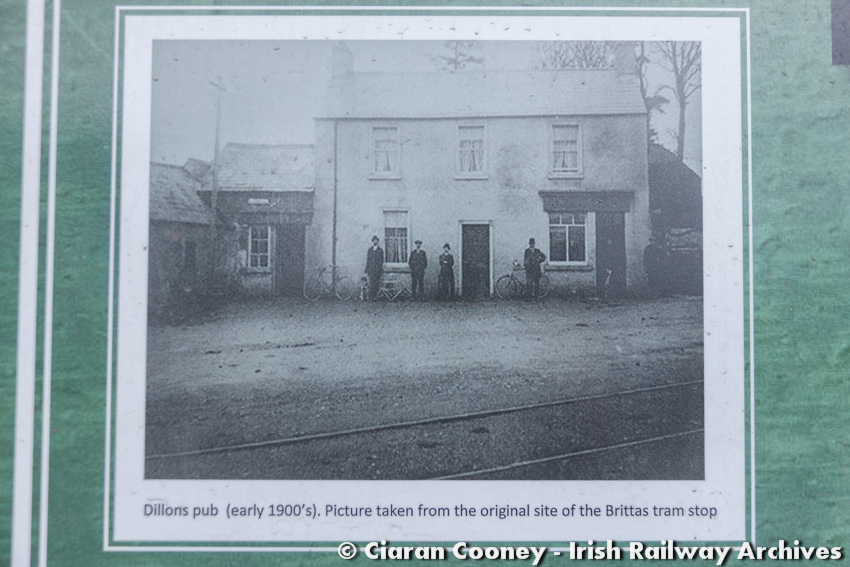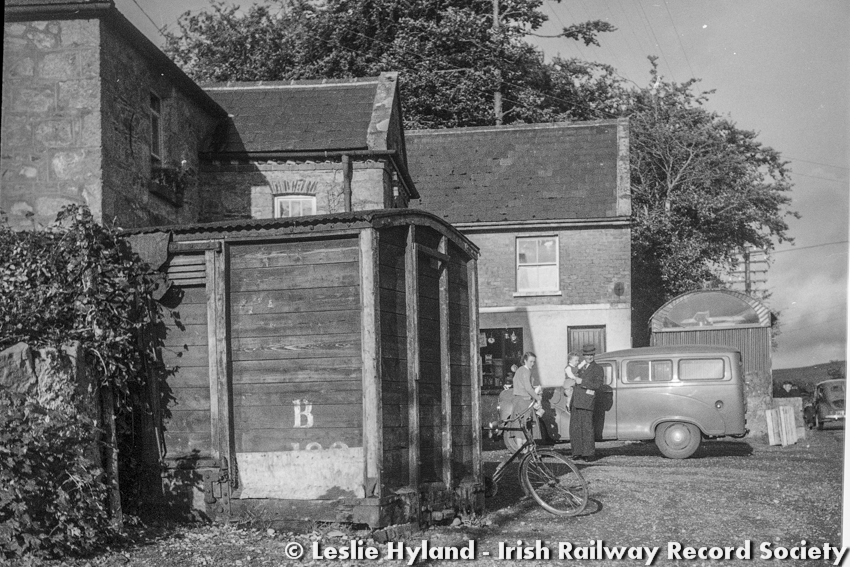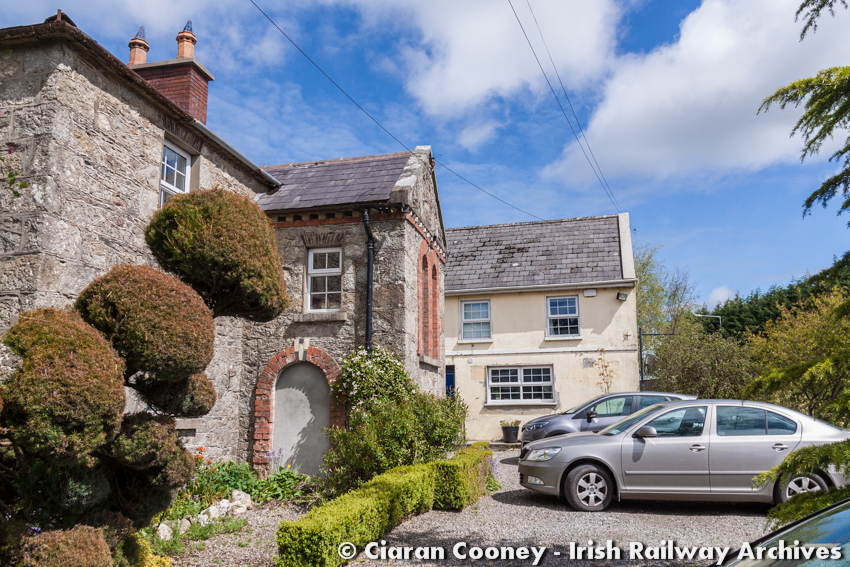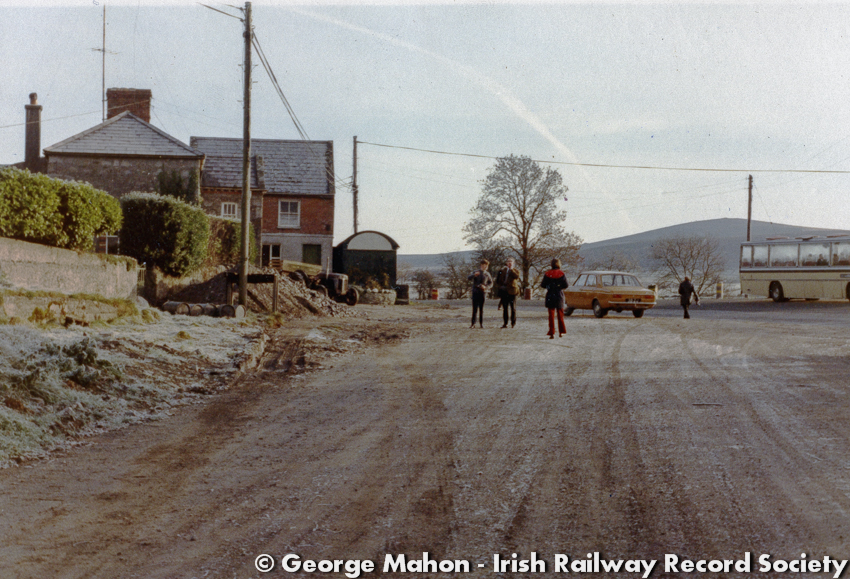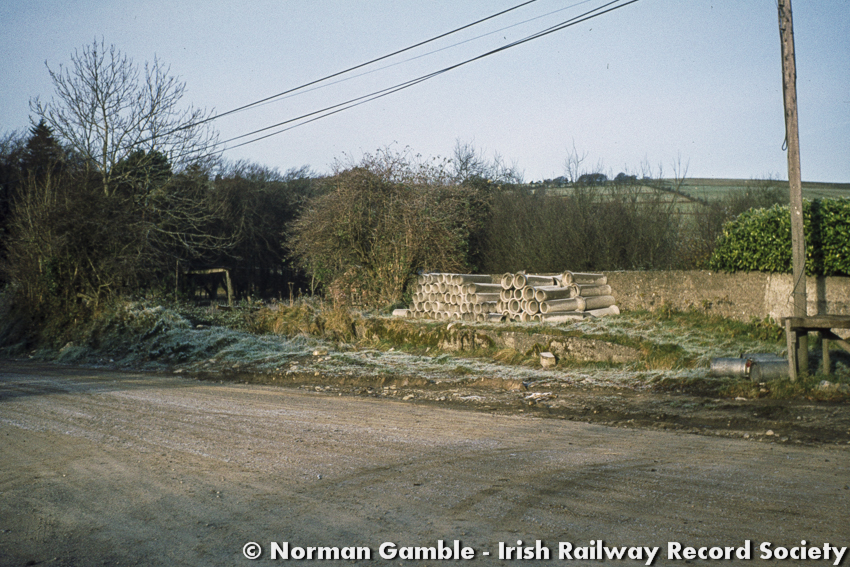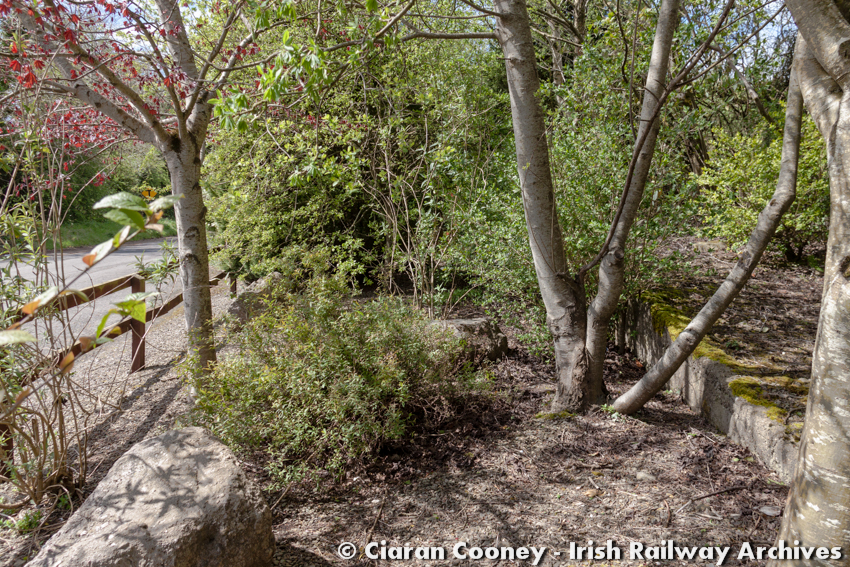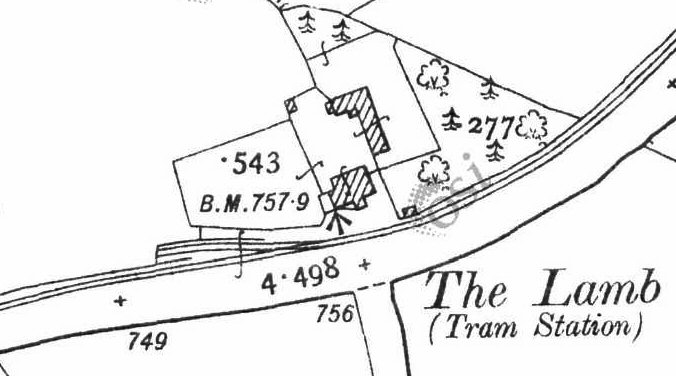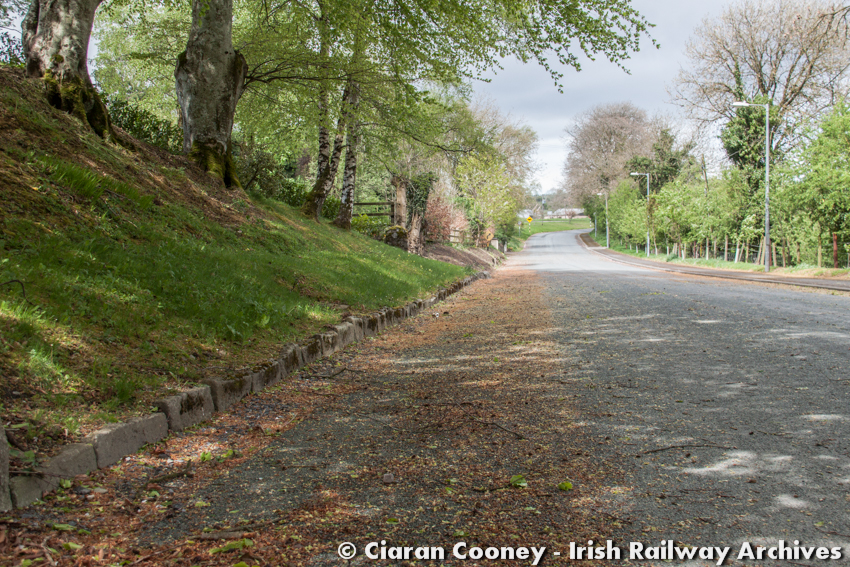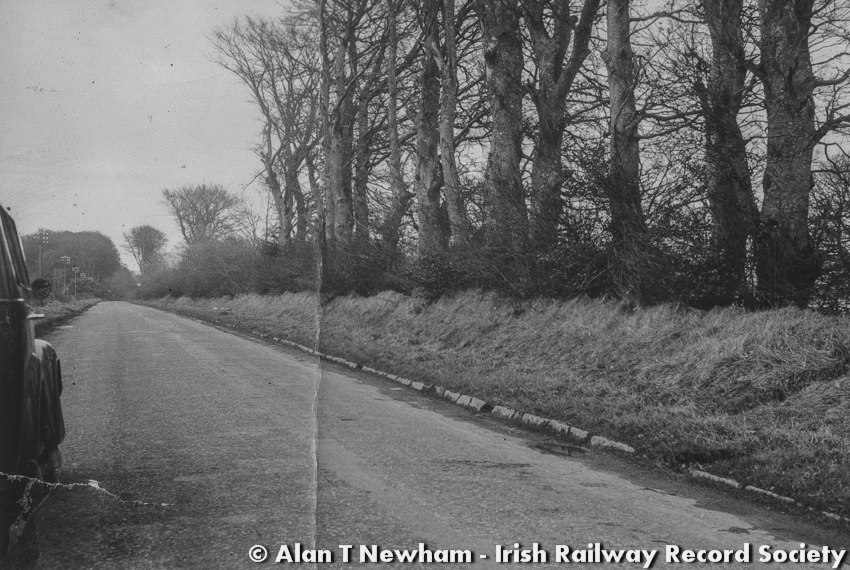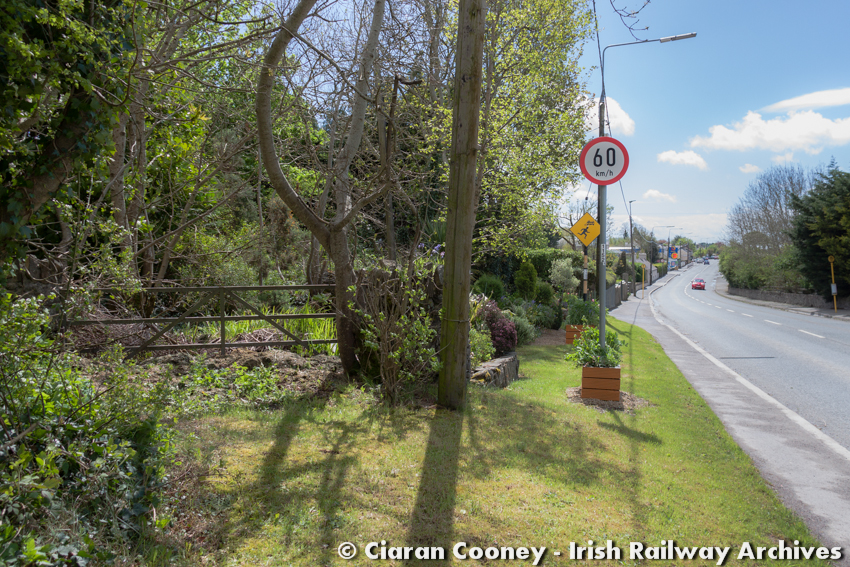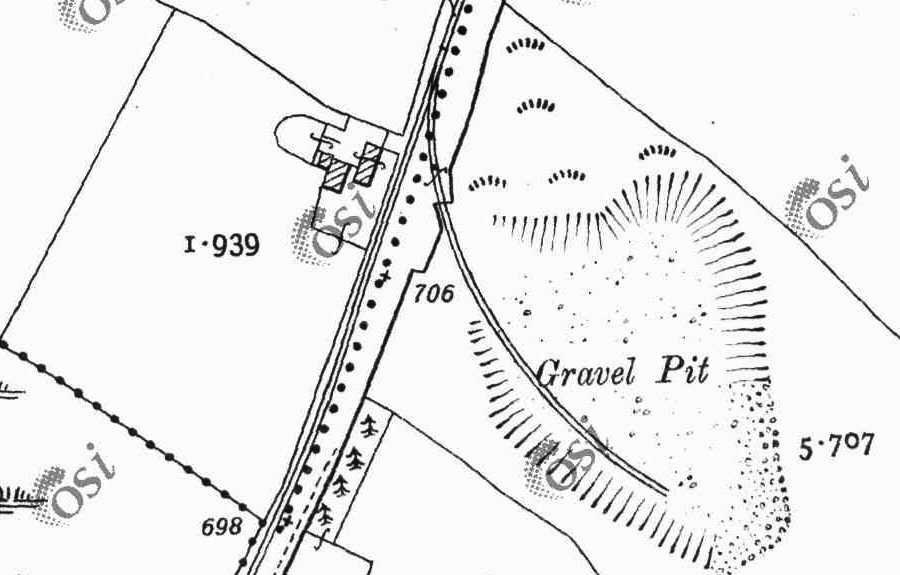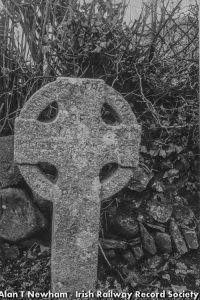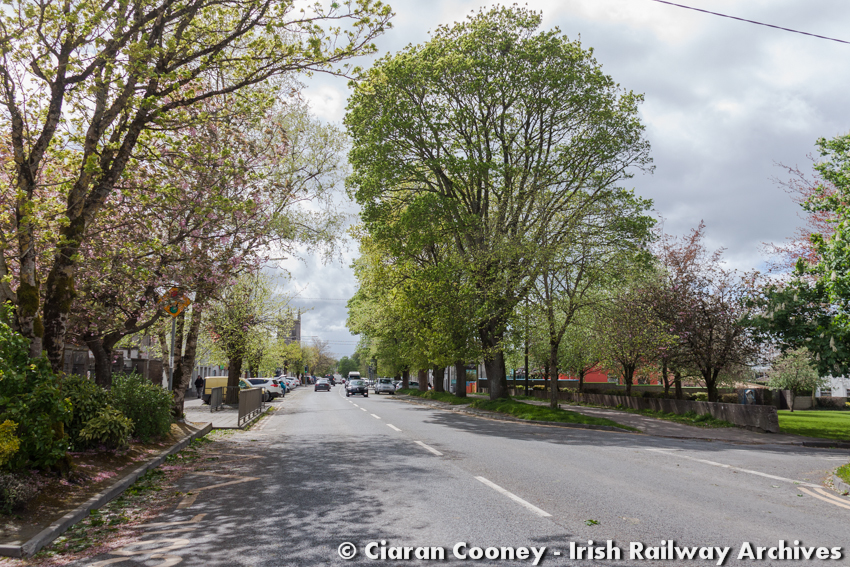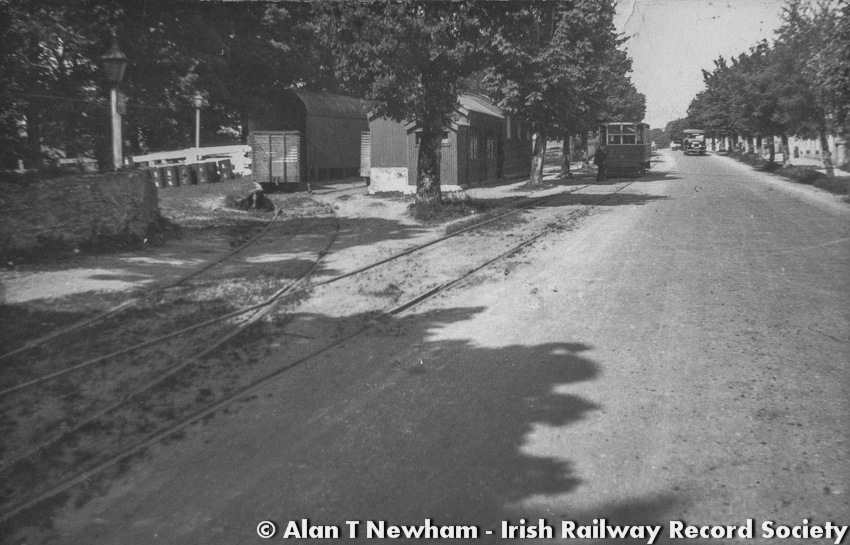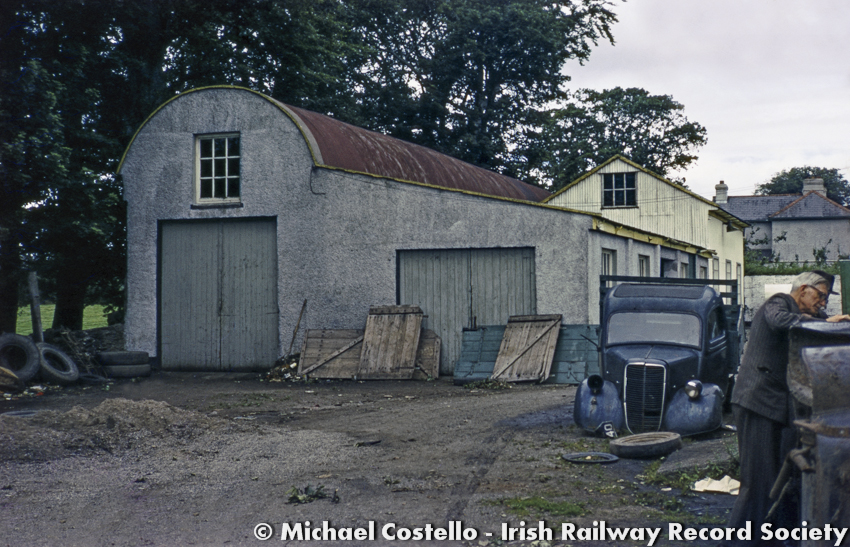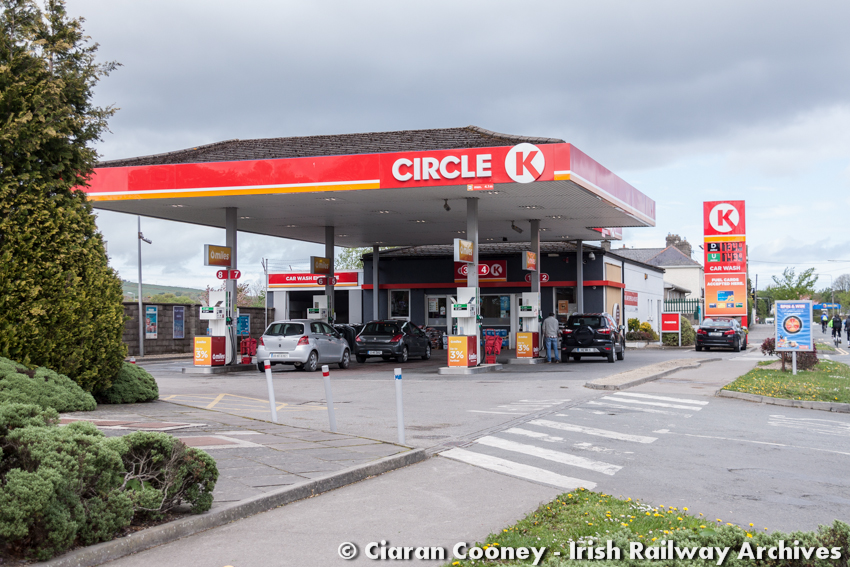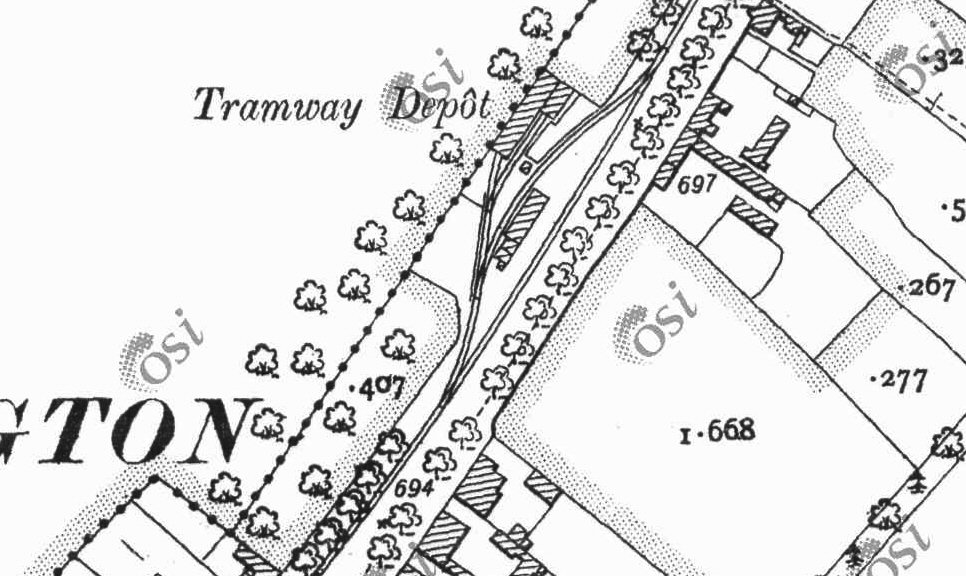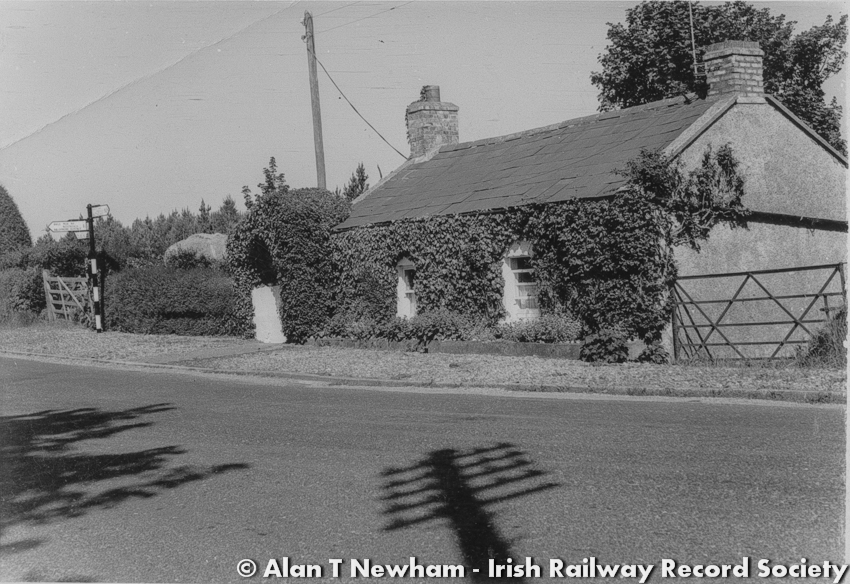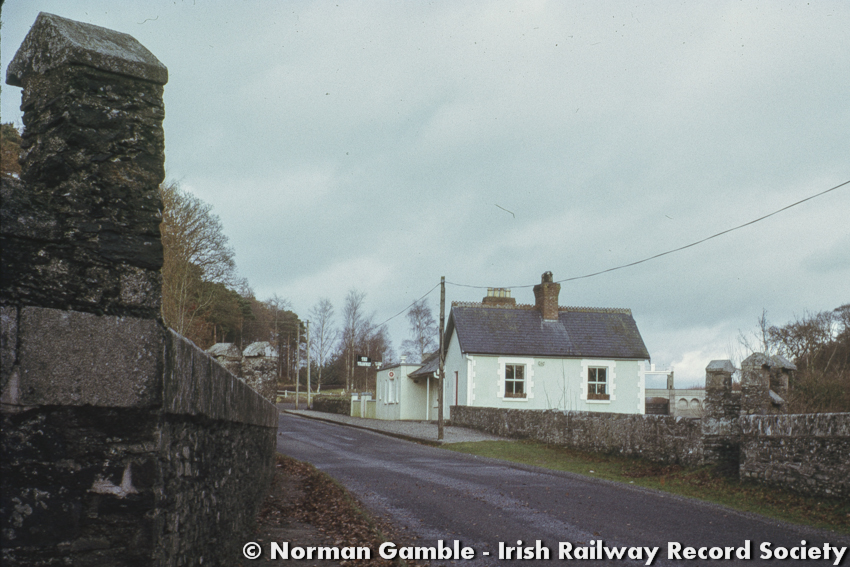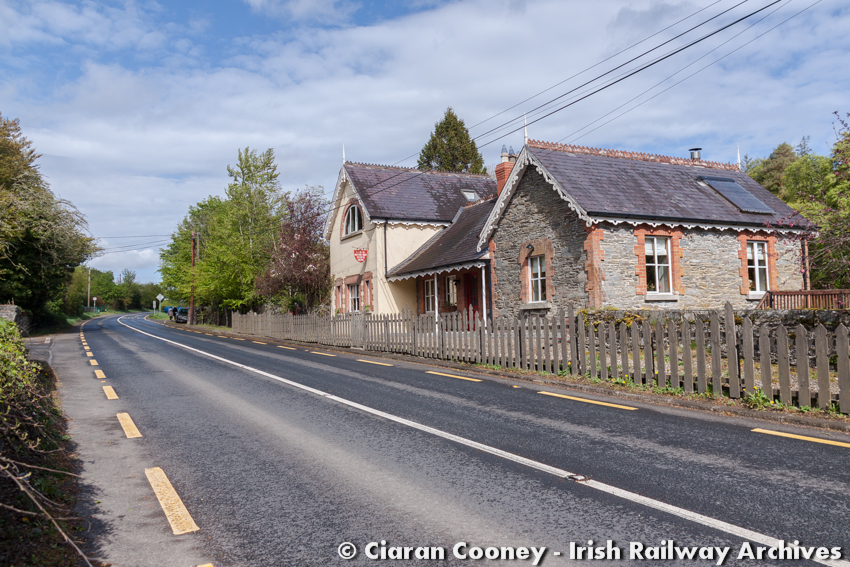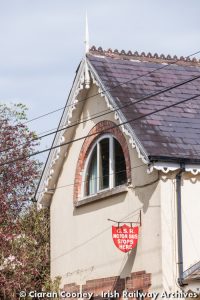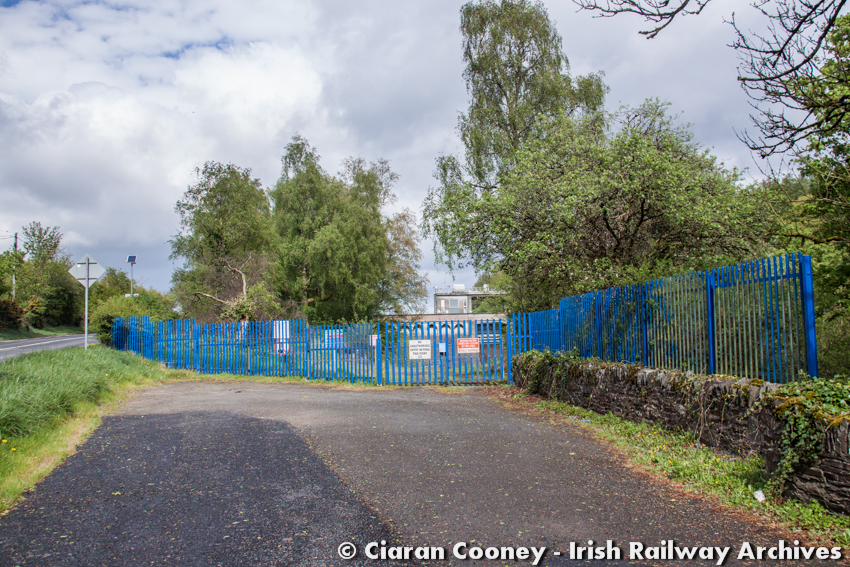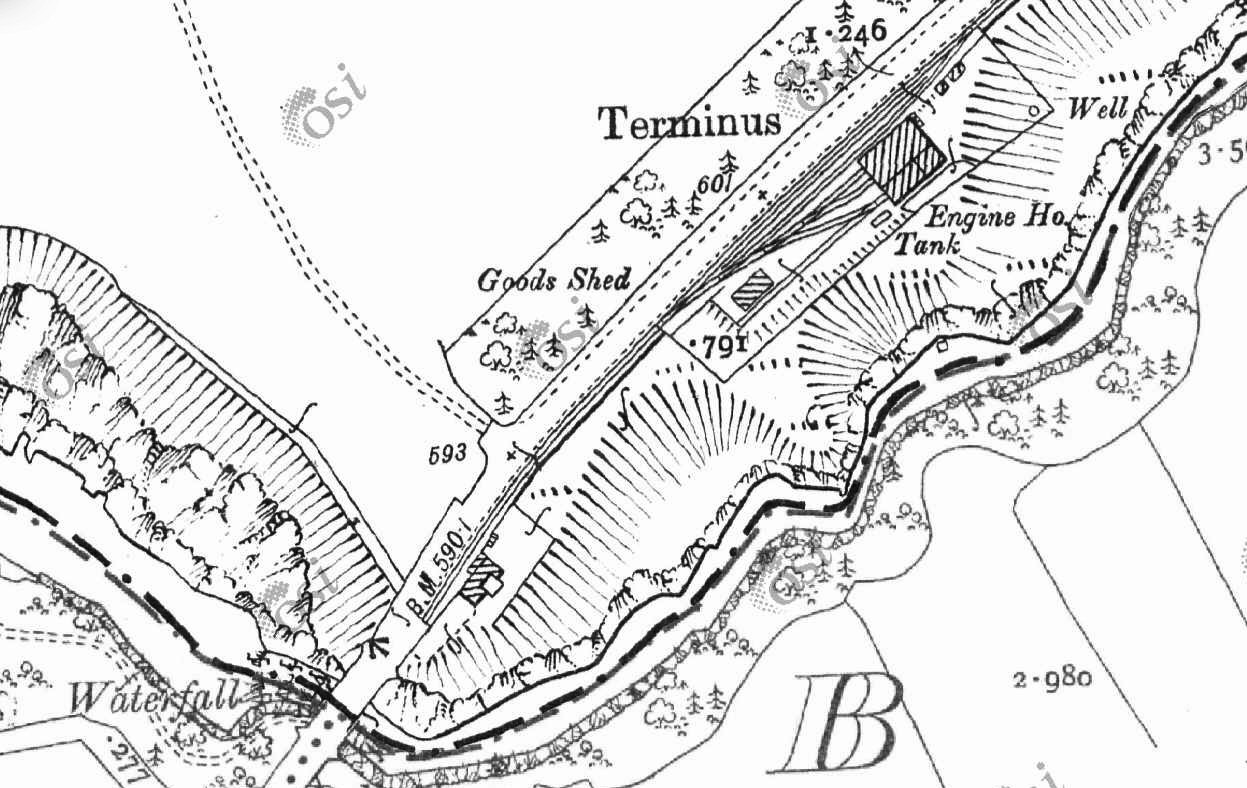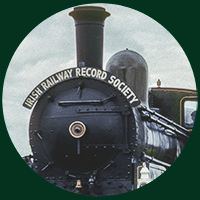Compiled by Ciarán Cooney, Hon Photographic Archivist
On Saturday 27 April 2019 I traced the route of the former Dublin & Blessington Steam Tramway . This line, effectively a roadside railway, ran 20¼ miles from Terenure in south west Dublin to Blessington and Poulaphouca in County Wicklow.
Approximately following the present-day N81 road, the single-track railway served locations such as Tallaght, Brittas and Ballymore Eustace , as it ascended the western side of the Wicklow Mountains. The section to Blessington opened in August 1888, with a further 5-mile extension to Poulaphouca Bridge been completed in May 1895. The construction of this latter section was overseen by a separate company, the Blessington & Poulaphouca Steam Tramway , but for all intent and purposes, was operated and managed by the parent company. Passenger services were operated by steam locomotives hauling tramcar trailers, with the goods traffic conveyed in a modest fleet of wagons.
Although closed 87 years ago and almost lost from living memory, there are visible remnants of the Blessington Tramway still in existence, as the following photo-feature illustrates. These are complemented by images from the archives of the Irish Railway Record Society and highlight some of the locations on the old line.
1) Embankment tram-stop
On 5 June 1932, D&BST locomotive No. 10 stands at the Embankment stop with a service from Terenure to Blessington, formed with two tram trailers. On the left is the water-tank for replenishing the steam locomotives. A passing loop on the left hand side of the tank enabled trams to cross here. [Photo ©Henry Casserley] Present day view of the Embankment , looking north towards Dublin on the N81 road. The site of the passing loop is visible to the left beside the Dublin Bus stop-sign. The car park formerly served the now closed Embankment Lounge & Bar. [Photo © Ciaran Cooney] Map showing the Embankment tram-stop, with the water-tank and passing loop visible. To avoid a sharp curve on the existing road, the tram line cut across an embankment (from which the stop took its name), clearly visible in this map. In the 1920s, the roadway was re-aligned parallel to the tram line. [Map ©OS Ireland] 2) Crooksling tram-stop
Having begun to ascend the Wicklow Mountains, the line reached Crooksling , where a passing loop and another water-tank was located. D&BST locomotive No. 6 is taking on water having arrived from Dublin hauling trailer No. 15, circa 1932. Visible in the background between the water-tank and the locomotive is the stone cross in memory of Sheila Fox, who was tragically killed by a tram at Crooksling. [Photo © RS Guinness – Irish Railway Record Society] Crooksling as today (27 April 2019), with the Sheila Fox stone-cross visible to the left beside the site of the water-tank and passing loop. This view is looking towards Dublin. [Photo © Ciaran Cooney]British railway photographer Henry Casserley recorded this view from the top of the tram trailer on the approach to the stop at Crooksling , en route to Blessington in June 1932. Note how close the track passes the farm out-building on the right. [Photo © Henry Casserley] A similar view to Casserley’s picture above of Crooksling , with the farm building visible on the right. After the tram closed, a stop for the replacement bus service was established here, now served by Dublin Bus. [Photo © Google Streetview]. Close-up photo of the Sheila Fox memorial cross at Crooksling , 27 April 2019. This cross was formerly one of several dedicated to those killed by the Blessington tram. [Photo © Ciaran Cooney] Map of Crooksling , showing the tram passing loop, the stone cross and the water tank. [Map © OS Ireland] 3) Brittas tram-stop
A mid-1950s view of the former tram-stop at Brittas , showing the grass covered trackbed looking towards Dublin, recorded approximately 30 years after the Blessington Tram closed. A passing loop was provided at Brittas, the two lines passing either side of the trees. [Photo © Alan T Newham – Irish Railway Record Society] Brittas in April 2019. As with similar stops along the route, a bus-stop was established here after 1932 when the tramway closed. Attached to the wall on the right is an information board with pictures detailing the history of the Blessington Tram. [Photo © Ciaran Cooney]Brittas , looking south towards Blessington, with the trackbed of the tram line in the foreground where the left-hand side of the passing loop was sited. In the background is a public house (Dillon’s Pub / Brittas Inn) where tickets for the tram were sold. [Photo © Ciaran Cooney]
This old photograph of the Dillons Pub at Brittas is displayed on the information board adjacent to the old tram-stop and shows the building in its original condition with the Blessington tram line in the foreground. Map showing the tram line through Brittas . Visible is the passing loop (the wide gap between the tracks indicating the line of trees). There was also a short siding at the Blessington end of the loop, and possibly a waiting shelter. [Map © OS Ireland] 4) The Lamb tram-stop
The Lamb tram-stop, the last significant stop before Blessington, recorded in the mid-1950s after the line closed. In the foreground is an old D&BST goods wagon (note the company’s ‘B’ initial). Beside the car on the right is the corrugated iron goods shed. [Photo © Leslie Hyland – Irish Railway Record Society]Alas the old D&BST goods wagon at The Lamb is gone. Also vanished is the goods shed. The adjacent buildings, formerly a shop (seen in Leslie Hyland’s photo) is now an antique premises. [Photo © Ciaran Cooney] Another view of The Lamb tram-stop, looking towards Dublin, recorded in November 1973 shortly after the road junction was significantly re-aligned away from the original route of the tram line. The goods shed was still in situ at this time. [Photo © George R Mahon – Irish Railway Record Society] Also clearly visible at The Lamb in 1973 was the old goods platform, located at the Blessington end of the tram-stop and formerly served by a siding. New road drainage pipes are seen stored on the platform during the road re-alignment works. [Photo © Norman Gamble – Irish Railway Record Society] The goods platform at The Lamb remarkably still exits in 2019, although it is somewhat obscured by vegetation, as seen here (the end ramp being visible on the right). The old road on the left remains for access to the antique shop. [Photo © Ciaran Cooney] The Lamb with its goods siding clearly visible. Unlike the other locations featured, there was no passing loop here. [Map © OS Ireland] 5) Santry Hill
Outside Blessington village at Santry Hill , an undisturbed section of the old N81 road remains (the present-day N81 avoids a particularly sharp bend). Along this short stretch of old road can be seen some original stone kerbing of the railway track. Most other trackside kerbing have long since been removed following road-widening over the previous five decades. For comparison, see the photograph below of a similar section recorded in the 1950s. [Photo © Ciaran Cooney] A section of disused trackbed on the Blessington line, photographed in the mid-1950s by IRRS member Alan Newham on the Blessington-Poulaphuca section near Russborough House, showing similar stone kerbing to that pictured in April 2019 outside Blessington village. [Photo © Alan T Newham – Irish Railway Record Society] 6) Blessington Quarry
Approaching Blessington village from the Dublin direction on the N81 road, the remains of an old gated siding leading off the tramway into a quarry can be seen on the left-hand side of the road, as pictured here. The siding faced the Dublin direction and the stone wall and its pillars survive. [Photo © Ciarán Cooney] Another view of the old quarry siding just outside Blessington village. This view is from the siding trackbed looking out onto the N81 road towards Dublin. It is unclear whether the iron gate dates from the time of the tramway. [Photo © Ciarán Cooney] OS map showing showing the siding diverging off the tram line and into the quarry (or gravel pit) on the northern approach to Blessington . The gate entrance to the siding is also clearly indicated. The quarry remains in use by Roadstone. [Map © OS Ireland] Immediately opposite the quarry siding outside Blessington is another old headstone erected in memory of another person killed by the Blessington tram. The headstone, now quite weathered, has lost its pillar and is positioned at ground level. [Photo © Ciarán Cooney] Alan Newham recorded the very same headstone as above, but in the mid-1950s, when the stone was more intact. The name is partly discernible (appearing to be a William Leeson? – if you know, please contact for clarification!). [Photo © Alan T Newham – Irish Railway Record Society] 7) Blessington Village
Seen in Blessington village awaiting departure for Terenure on 5 June 1932, is D&BST locomotive No. 10, hauling two tram trailers. This view is looking south towards Poulaphouca, although the section of the line to that terminus had closed by 1927. [Photo © Henry Casserley / Irish Railway Record Society] A similar view to Casserly’s photograph of Blessington above, again looking south towards Poulaphouca, showing the distinctive tree-lined main street. The tram terminus and depot of the D&BST was located here at the northern end of the village. [Photo © Ciarán Cooney] The D&BST terminus and depot in Blessington , located at the northern end of the main street. This view, dating circa 1932, is looking towards Dublin, with the siding on the left serving a goods platform and cattle dock. Also visible is the corrugated-iron built tramway offices. D&BST railcar No. 3 is parked on the main line ready to return to Dublin. [Photo © Alan T Newham – Irish Railway Record Society] The D&BST depot in Blessington , recorded in June 1932, showing left to right; the cattle dock, tram trailer shed, locomotive shed and water tower, as well as engine No. 10. [Photo © Henry Casserley / Irish Railway Record Society] After the tramway closed in 1932, the depot at Blessington became a garage which incorporated some of the original structures, as shown in this scene dating from August 1963. [Photo © Michael Costello – Irish Railway Record Society] A present-day view of the D&BST depot and terminus site in Blessington , which is still occupied by a garage. The two-storey house visible in the background beyond the garage appears in the previous archive photographs. [Photo © Ciarán Cooney] At the northern end of the main street in Blessington village is the demarcation boundary between the two separate sections of the tramway, as indicated by this stone marker bearing the two companies initials; the Blessington & Poulaphouca and the Dublin & Blessington, the sections opening in 1888 and 1895 respectively. [Photo © Ciarán Cooney] View from the Blessington & Poulaphuca Tramway side of the stone marker in Blessington village, still in-situ in 2019 87 years after the tramway closed. This view is looking towards Dublin in the direction of the Blessington terminus and depot. [Photo © Ciarán Cooney] Map showing the D&BST depot and terminus at the northern end of Blessington , with the 5-mile extension towards Poulaphouca continuing south through the main street of the village, circa 1906. [Map © OS Ireland] 8) Ballymore Road tram-stop (Ballymore Eustace)
The last stop on the D&BST line before the terminus at Poulaphouca was at Ballymore Road , where a siding, cattle dock and corrugated-iron goods store was provided, the latter pictured here in 1969 in use as a confectionery shop (adorned with tobacco advertising) long after the line closed. [Photo © Alan T Newham – Irish Railway Record Society] Ballymore Road goods store, pictured in April 2019, is likely to be the last surviving example of the numerous corrugated-iron structures once found at many of the principal stops on the Dublin & Blessington Tramway. This stop primarily served nearby Ballymore Eustace. [Photo © Ciarán Cooney]Described by Alan Newham as a ‘tramway cottage’ in 1969, this small cottage is also located at the Ballymore Road tram-stop, opposite the junction with the road leading to Ballymore Eustace, as indicated by the sign-posts. [Photo © Alan T Newham – Irish Railway Record Society] The ‘tramway cottage’ at Ballymore Road , pictured from the N81 road in April 2019, has been rebuilt somewhat since Alan Newham recorded the scene 50 years previously. [Photo © Ciarán Cooney] Ballymore Road tram-stop, showing the siding and goods store, which was located on the opposite side of the Blessington-Poulaphouca road, necessitating the access siding to cross the roadway. Note that the goods facilities also included a crane. The narrower road diverging north leads to Ballymore Eustace. [Map © OS Ireland]9) Poulaphouca terminus
Refurbished D&BST tram trailer No. 15, pictured at the end of the line at Poulaphouca , just short of the bridge over the River Liffey. This scene was likely recorded just before the Blessington-Poulaphouca section closed in 1927. Behind the trailer can be seen the small stone built booking office and waiting room. [Photo © Irish Railway Record Society] The D&BST booking office and waiting room at Poulaphouca survives as a private residence, pictured here in November 1973. Just visible above the castellated parapets of the River Liffey bridge is the Pollaphuca dam, part of the ESB hydroelectric generating station and Reservoir. [Photo © Norman Gamble – Irish Railway Record Society] Closer view of the stone-built D&BST booking office and waiting room at Poulaphouca . A neat sympathetic two-storey extension has been added to the Dublin end of the structure. The low footpath in front of the building also served as a platform for boarding the trams. [Photo © Ciarán Cooney] Closer view of the two-storey extension at the D&BST terminus at Poulaphouca, which features a vintage Great Southern Railways bus-stop sign. [Photo © Ciarán Cooney] At the northern end of the terminus at Poulaphouca is the site of the old locomotive shed and sidings, nowadays in use as an access point to the ESB hydroelectric dam. To the left is the N81 road leading back towards Blessington and Dublin, the trams facing a steep ascent when departing from the terminus. [Photo © Ciarán Cooney] End of the line at Poulaphouca , showing the road bridge spanning the River Liffey and the adjacent well-known waterfall. The locomotive shed, sidings (and possible goods shed) were located at the Blessington end just short of the passenger terminus. [Map © OS Ireland] A Dublin & Blessington survivor (Railcar No. 3):
D&BST petrol-engined railcar No. 3, recorded in 1932 at the city terminus in Terenure, Dublin. This railcar, which could be driven from either end, was built by the Drewery Company and entered service in the last few years of the line’s existence. Upon closure of the Blessington, it was purchased by the County Donegal Railway and re-gauged to 3ft for use on that company’s system. [Photo © Kevin A Murray – Irish Railway Record Society] The ex-D&BST railcar No. 3, pictured in its County Donegal Railway days as a trailer at Stranorlar in May 1959. The railcar’s 35hp engine was removed in 1944, becoming a trailer coach for the remainder of its days in Donegal. Fortunately this historic vehicle from the Dublin & Blessington Tramway can nowadays be seen at the Ulster Folk & Transport Museum at Cultra, Belfast – See HERE Blessington Tram Addendum:
A poem about the Blessington line was written by the late Barry Tynan O’Mahony , the last few lines of which appeared in 1953 in the Sunday Press, and ran as follows:
“But yet I have a feeling, when the world’s come to an end, That the steam tram will come stealing like an old and trusted friend, When we’re standing round in billions trying to get across the Styx, And the cars are lined in millions, and we’re really in a fix, When the buses cannot shift on, and the traffic’s all a jam, Perhaps we’ll get a lift on . . . THE OLD-STEAM-TRAM.”
Bibliography: The Dublin & Blessington Steam Tramway, 1963
This archive photo-feature has been compiled by Ciarán Cooney, Hon Photographic Archivist of the Irish Railway Record Society’s library and archives at Heuston Station, Dublin. Further images from the Society’s collection can be found on the IRRS’s Photographic Archive Membership Page
Please follow and like us:

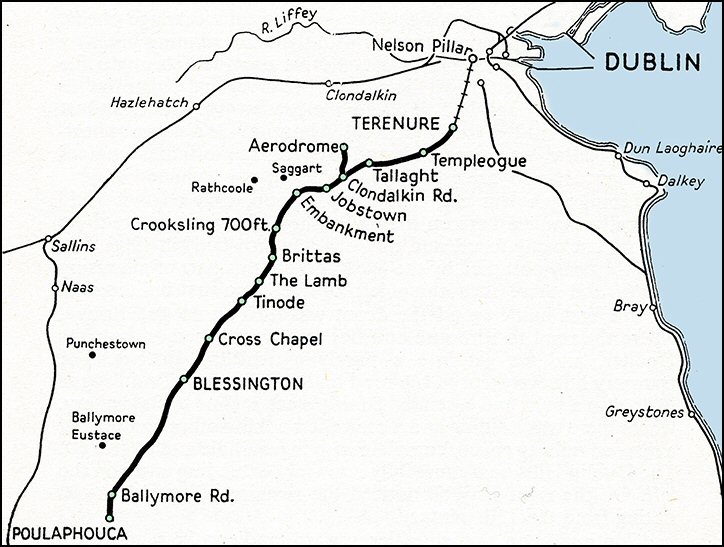 Serving sparsely populated areas and relying on agricultural traffic, the tramway never achieved a prosperous life. Following the Great War, the tramway was adversely affected by bus and lorry competition, while the condition of its own rolling stock gradually deteriorated due to the company’s financial constraints. In its final years, cost-effective petrol-engined railcars were operated alongside the steam fleet, but this ultimately did not save the tramway, which closed on 1 January 1933, the section between Blessington and Poulaphouca having shut five years earlier in September 1927.
Serving sparsely populated areas and relying on agricultural traffic, the tramway never achieved a prosperous life. Following the Great War, the tramway was adversely affected by bus and lorry competition, while the condition of its own rolling stock gradually deteriorated due to the company’s financial constraints. In its final years, cost-effective petrol-engined railcars were operated alongside the steam fleet, but this ultimately did not save the tramway, which closed on 1 January 1933, the section between Blessington and Poulaphouca having shut five years earlier in September 1927. 